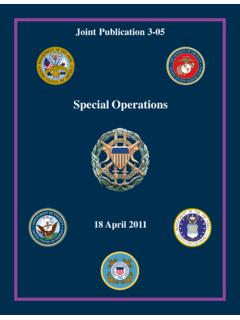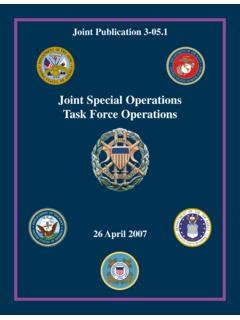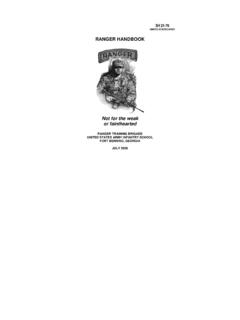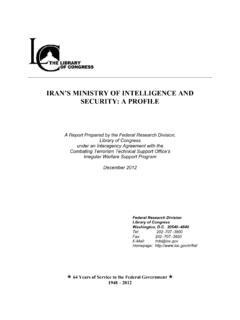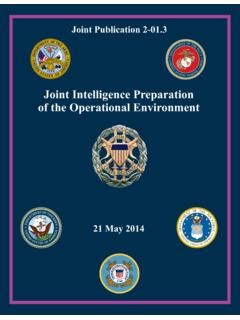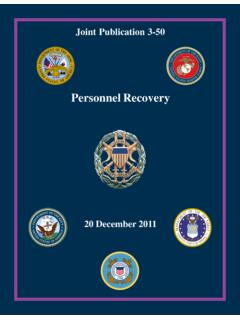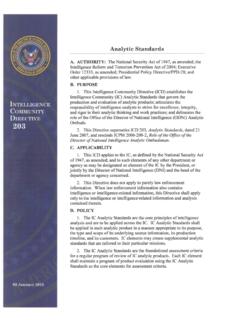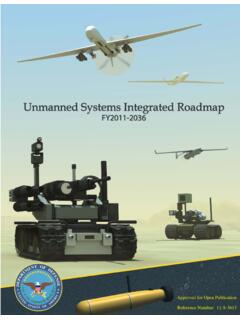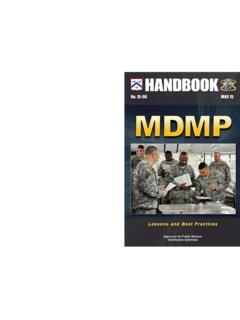Transcription of Joint Maritime Operations - Federation of American Scientists
1 DEPAOTMENTFTHEARMY EUNITEDSTATSOAFAMERICRTHISWE'LLDEFENDJ oint Publication 3-32 Joint Maritime Operations08 June 2018 Incorporating Change 120 September 2021i PREFACE 1. Scope This publication provides fundamental principles and guidance for Joint Maritime Operations . It describes the Maritime domain; addresses considerations for establishing a Joint force Maritime component commander and attendant command relationships; and provides principles and guidance to plan, execute, and assess Joint Maritime Operations . 2. Purpose This publication has been prepared under the direction of the Chairman of the Joint Chiefs of Staff (CJCS). It sets forth Joint doctrine to govern the activities and performance of the Armed Forces of the United States in Joint Operations , and it provides considerations for military interaction with governmental and nongovernmental agencies, multinational forces, and other interorganizational partners.
2 It provides military guidance for the exercise of authority by combatant commanders and other Joint force commanders (JFCs), and prescribes Joint doctrine for Operations and training. It provides military guidance for use by the Armed Forces of the United States in preparing and executing their plans and orders. It is not the intent of this publication to restrict the authority of the JFC from organizing the force and executing the mission in a manner the JFC deems most appropriate to ensure unity of effort in the accomplishment of objectives. 3. Application a. Joint doctrine established in this publication applies to the Joint Staff, commanders of combatant commands, subordinate unified commands, Joint task forces, subordinate components of these commands, the Services, the National Guard Bureau, and combat support agencies.
3 B. This doctrine constitutes official advice concerning the enclosed subject matter; however, the judgment of the commander is paramount in all situations. Preface ii JP 3-32 (CH 1) c. If conflicts arise between the contents of this publication and the contents of Service publications, this publication will take precedence unless the CJCS, normally in coordination with the other members of the Joint Chiefs of Staff, has provided more current and specific guidance. Commanders of forces operating as part of a multinational (alliance or coalition) military command should follow multinational doctrine and procedures ratified by the United States. For doctrine and procedures not ratified by the US, commanders should evaluate and follow the multinational command s doctrine and procedures, where applicable and consistent with US law, regulations, and doctrine.
4 For the Chairman of the Joint Chiefs of Staff: KEVIN D. SCOTT Vice Admiral, USN Director, Joint Force Development iii SUMMARY OF CHANGES REVISION OF Joint PUBLICATION 3-32 DATED 07 AUGUST 2013 Changes title from Command and Control for Joint Maritime Operations . Revises scope statement. Revises discussion of composite warfare and adds a figure on composite warfare commander organization. Revises command and control considerations for specific Maritime Operations . Adds a paragraph on seapower essential functions. Adds figure on operational employment constructs for amphibious ready groups and marine expeditionary units (aggregated, disaggregated, distributed). Removes discussion of global fleet station, Maritime Civil Affairs and Security Training Command, and Maritime expeditionary security force.
5 Revises the discussion on Maritime domain awareness. Enhances discussion on assessment. Enhances consistency among other doctrinal publications and Department of Defense (DOD) and other United States Government policies. Modifies, adds, and removes terms and definitions from the DOD Dictionary of Military and Associated Terms. Summary of Changes iv JP 3-32 (CH 1) Intentionally Blank v TABLE OF CONTENTS EXECUTIVE SUMMARY .. ix CHAPTER I INTRODUCTION General .. I-1 General Approach to Command and Control .. I-2 Seapower Essential Functions .. I-3 Joint Maritime Operations .. I-4 Maritime Domain .. I-5 CHAPTER II ORGANIZING FOR Joint Maritime Operations General Organizational Options.
6 II-1 Component Employment Considerations .. II-3 Command Relationships and Responsibilities .. II-6 Organizing and Manning the Component Headquarters .. II-11 Task Organization of Subordinate Forces .. II-13 Navy Composite Warfare Doctrine .. II-14 Marine Air-Ground Task II-16 Multinational Considerations .. II-16 Supported Maritime Commander Considerations .. II-17 Supporting Maritime Commander II-17 CHAPTER III PLANNING Joint Maritime Operations Maritime Planning Processes and Products .. III-1 Integration with Joint Planning Process .. III-2 Organizing the Operational Area .. III-2 Other General Planning Considerations .. III-3 Assessment .. III-16 Multinational Participation .. III-18 CHAPTER IV COMMAND AND CONTROL AND OTHER OPERATIONAL-LEVEL CONSIDERATIONS FOR SPECIFIC Maritime Operations General.
7 IV-1 Surface Warfare .. IV-1 Air and Missile Defense .. IV-5 Table of Contents vi JP 3-32 (CH 1) Antisubmarine IV-10 Mine Warfare .. IV-14 Strike Warfare .. IV-16 Amphibious Operations .. IV-17 Naval Surface Fire Support .. IV-17 Commander s Communication Synchronization .. IV-18 Maritime Interception Operations .. IV-19 Maritime Security Operations .. IV-22 Maritime Homeland Defense and Defense Support of Civil Authorities .. IV-23 Global Maritime Partnerships and Security Cooperation .. IV-24 Sea-Based Operations .. IV-25 Counterdrug Operations .. IV-27 Noncombatant Evacuation Operations .. IV-28 Protection of Shipping .. IV-28 Maritime Pre-Positioning Force Operations .. IV-30 Foreign Humanitarian Assistance.
8 IV-30 Maritime Operational Threat Response .. IV-31 Riverine Operations .. IV-32 APPENDIX A Detainee Operations at Sea .. A-1 B References .. B-1 C Administrative Instructions .. C-1 GLOSSARY Part I Abbreviations, Acronyms, and Part II Terms and Definitions ..GL-5 FIGURE I-1 Legal Boundaries of the Oceans and Airspace .. I-6 II-1 Typical Joint Force Maritime Component Commander Responsibilities .. II-2 II-2 Operational Employment for Amphibious Ready Groups with Embarked Marine Expeditionary Units .. II-4 II-3 Sample Battle Rhythm .. II-12 II-4 Generic Seven-Minute Drill Example .. II-13 II-5 Composite Warfare Commander Organization .. II-17 III-1 Notional Intelligence directorate Augmentation Requirements.
9 III-5 III-2 Joint Force Maritime Component Commander Targeting Functions and Responsibilities .. III-7 III-3 Environmental Considerations .. III-13 III-4 Primary Zones Affecting Navigation and Overflight .. III-15 IV-1 Notional Maritime Task Organization .. IV-2 Table of Contents vii IV-2 Composite Warfare Commander Integration within the Joint Operations Area .. IV-3 IV-3 Examples of Maritime Ballistic Missile Defense Command Functions .. IV-7 IV-4 Notional Ballistic Missile Defense Command Relationships and Functions .. IV-8 Table of Contents viii JP 3-32 (CH 1) Intentionally Blank ix EXECUTIVE SUMMARY COMMANDER S OVERVIEW Discusses the Responsibilities of a Joint Force Maritime Component Commander Explains the Five Essential Functions of Seapower Outlines Organizational Options and Command Relationships for Various Maritime Operations Describes the Maritime Domain Discusses Planning Considerations for Joint Maritime Operations Introduction Maritime Operations include any actions performed by Maritime forces to gain or exploit command of the sea, sea control, and/or sea denial, or to project power from the sea.
10 Sea control may include naval cooperation and guidance for shipping, protection of sea lines of communications, air lines of communications, blockades, embargoes against economic or military shipping, and Maritime interception Operations (MIO). Maritime Operations also encompass Operations to locate, classify, track, and target surface vessels, submarines, and aircraft. In addition, amphibious Operations increase the commander s options for maneuver in the littorals and forcible entry Operations . General Approach to Command and Control The Joint force Maritime component commander (JFMCC) must have the capability to exercise command and control (C2) of Maritime forces and to accomplish a broad range of missions in denied or degraded environments.
